R语言 ggplot中移动坐标轴标签
在这篇文章中,我们将看到如何在R编程语言中使用ggplot2条形图移动轴的标签。
首先,如果之前没有在R Studio中安装ggplot2软件包,你需要安装它。为了创建一个简单的柱状图,我们将使用函数 geom_bar()
语法
geom_bar(stat, fill, color, width)
参数 :
- stat : 设置stat参数以确定模式。
- fill : 代表条形图内部的颜色。
- color : 代表条形图轮廓的颜色。
- width : 代表条形图的宽度。
使用中的数据
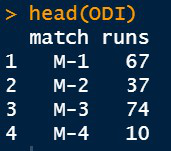
让我们看看没有任何修改的默认绘图是什么样子的。
library(ggplot2)
# Inserting data
ODI <- data.frame(match=c("M-1","M-2","M-3","M-4"),
runs=c(67,37,74,10))
head(ODI)
# Default axis labels in ggplot2 bar plot
perf <-ggplot(data=ODI, aes(x=match, y=runs,fill=match))+
geom_bar(stat="identity")
perf
输出

默认情况下,R将在数据框中分配的矢量名称作为轴的标题。要手动添加轴标题,请使用以下命令。
// 要修改X轴的标签
xlab(“X_axis_Labelname”)
// 要修改Y轴的标签
ylab(“Y_axis_Labelname”)
// 同时修改x轴和y轴的标题
labs(x=”X_axis_Labelname”,y=”Y_axis_Labelname”)
例子
library(ggplot2)
# Inserting data
ODI <- data.frame(match=c("M-1","M-2","M-3","M-4"),
runs=c(67,37,74,10))
head(ODI)
# Default axis labels in ggplot2 bar plot
perf <-ggplot(data=ODI, aes(x=match, y=runs,fill=match))+
geom_bar(stat="identity")
perf
# Manually adding axis labels
ggp <- perf+labs(x="Matches",y="Runs Scored")
ggp
输出
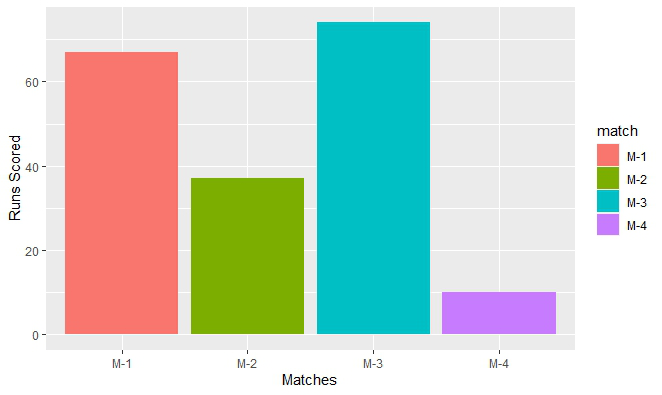
为了对轴标签进行任何修改,我们使用函数 element_text( ) 这个函数的参数是 :
- Color
- Size
- Face
- Family
- lineheight
- hjust and vjust
取值范围是 [ 0 ,1] ,其中 :
//描述轴的最左角
hjust = 0
//描述轴的中间部分
hjust = 0.5
//描述轴的最右角
hjust = 1
让我们首先创建一个轴标签朝左的图。
例子
library(ggplot2)
# Inserting data
ODI <- data.frame(match=c("M-1","M-2","M-3","M-4"),
runs=c(67,37,74,10))
head(ODI)
# Default axis labels in ggplot2 bar plot
perf <-ggplot(data=ODI, aes(x=match, y=runs,fill=match))+
geom_bar(stat="identity")
perf
# Manually adding axis labels
ggp <- perf+labs(x="Matches",y="Runs Scored")
ggp
# Moving axis label to left
ggp + theme(
axis.title.x = element_text(hjust=0),
axis.title.y = element_text(hjust=0)
)
输出
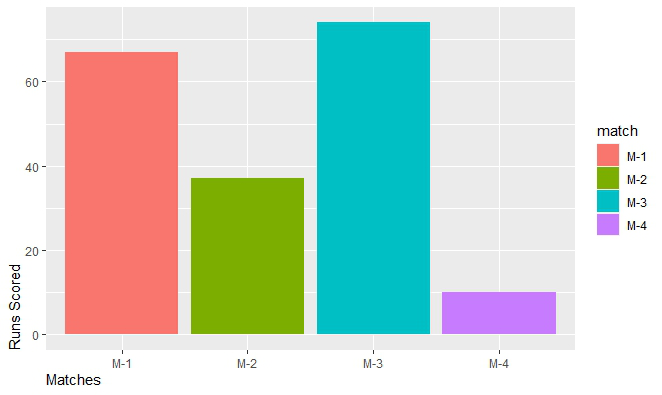
现在让我们把它们移到中心。
例子
library(ggplot2)
# Inserting data
ODI <- data.frame(match=c("M-1","M-2","M-3","M-4"),
runs=c(67,37,74,10))
head(ODI)
# Default axis labels in ggplot2 bar plot
perf <-ggplot(data=ODI, aes(x=match, y=runs,fill=match))+
geom_bar(stat="identity")
perf
# Manually adding axis labels
ggp <- perf+labs(x="Matches",y="Runs Scored")
ggp
# Moving axis label in middle
ggp + theme(
axis.title.x = element_text(hjust=0.5),
axis.title.y = element_text(hjust=0.5)
)
输出
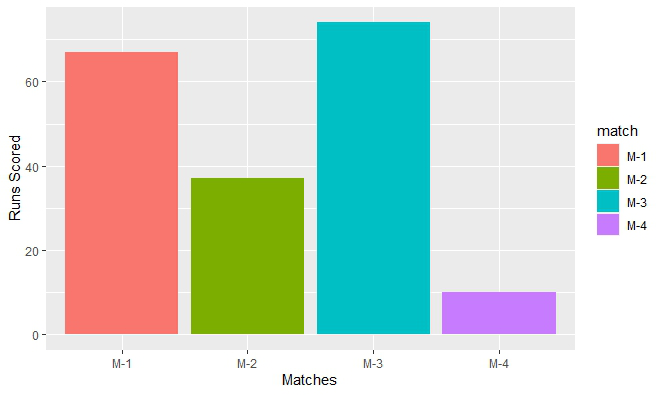
类似的做法也可以用于向右移动它们。
例子
library(ggplot2)
# Inserting data
ODI <- data.frame(match=c("M-1","M-2","M-3","M-4"),
runs=c(67,37,74,10))
head(ODI)
# Default axis labels in ggplot2 bar plot
perf <-ggplot(data=ODI, aes(x=match, y=runs,fill=match))+
geom_bar(stat="identity")
perf
# Manually adding axis labels
ggp <- perf+labs(x="Matches",y="Runs Scored")
ggp
# Moving axis label to right
ggp + theme(
axis.title.x = element_text(hjust=1),
axis.title.y = element_text(hjust=1)
)
输出
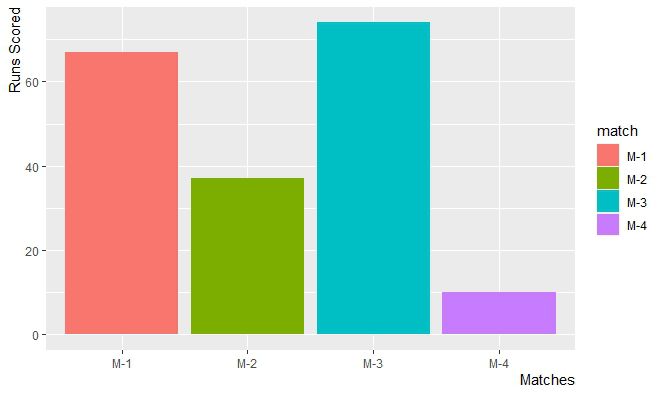
 极客教程
极客教程